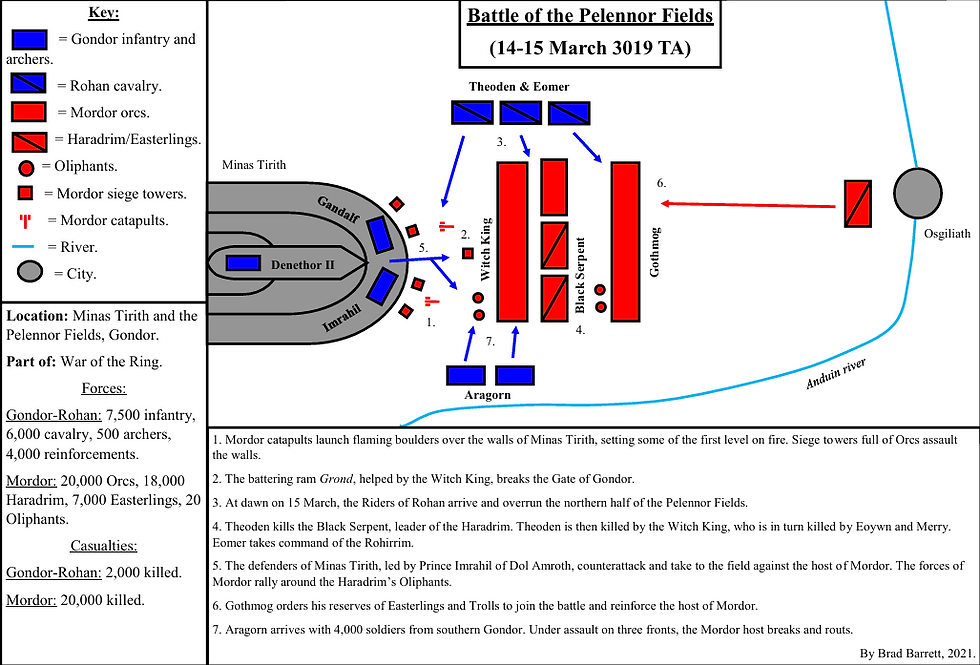The Battle of the Pelennor Fields.
- Brad Barrett

- Oct 10, 2021
- 4 min read
Updated: Dec 6, 2025

On 14-15 March 3019 TA, the Battle of the Pelennor Fields was fought in Middle Earth between Gondor and Rohan under Denethor II and King Theoden against Mordor under the Witch-King and Gothmog during the War of the Ring.
Why did it happen?
On 6 March 3019 TA, two days after the Battle of the Hornburg and the destruction of Isengard, Aragorn revealed himself to Sauron through the Palantir of Orthanc as the Heir of Isildur. This event stirred Sauron into action by initiating his long-planned attack on Gondor, and on 10 March the Witch King of Angmar marched his armies out of Minas Morgul along the road to Osgiliath and Minas Tirith. At the same time, the Beacons of Gondor were lit to summon aid from Rohan, who had sworn an oath 500 years earlier to aid Gondor in times of war. On 12 March, the Witch King’s army attacked Osgiliath, forcing its garrison of 2,000 men to retreat. On 13 March, combined with an army that had marched out of the Black Gate, the Witch King’s forces overran the Pelennor Fields and established trenches and siege engines in front of the city of Minas Tirith.
Who was involved?
The combined forces of Gondor and Rohan at the Pelennor Fields numbered 7,500 infantry, 6,000 cavalry and 500 archers. Of this number, 8,000 were stationed inside the city of Minas Tirith under the command of Denethor II, Gandalf and Prince Imrahil, while the remaining 6,000 cavalry arrived on 15 March under King Theoden. In addition, 4,000 reinforcements consisting of infantry and archers led by Aragorn arrived on the second day of the battle. The army of Mordor at the Pelennor Fields numbered 20,000 Orcs, 18,000 Haradrim, 7,000 Easterlings and 20 Oliphants, making it one of the largest armies fielded during the entire Third Age. In addition to these forces, the Mordor host also came equipped with catapults and siege towers to assault the walls of Minas Tirith while a large Battering Ram called Grond was used to assault the gate.
What happened?
On 14 March, the Siege of Minas Tirith began when Mordor catapults launched flaming boulders over the walls of Minas Tirith, setting the lower levels on fire, while siege towers full of Orcs assaulted the walls. Throughout the night, the great battering ram Grond was used to besiege the gate of Minas Tirith, which finally managed to break it open on the morning of 15 March with the help of the Witch King. Before Mordor’s forces could pour into the breach, however, Theoden arrived from the north with 6,000 cavalry and overran the northern half of the Pelennor Fields. Riding through the ranks of Mordor, Theoden personally slew the leader of the Haradrim, the Black Serpent, before being mortally wounded by the Witch King. The Witch-King was then killed by Eowyn and Merry before Eomer took command of the Rohirrim. The defenders inside Minas Tirith then sallied forth from the city under Prince Imrahil of Dol Amroth to counterattack the Witch King’s army, which was now led by the Orc commander, Lieutenant Gothmog. Many Orcs and Haradrim rallied around the giant Oliphants which the Haradrim had brought with them from Harad, and while they could sustain considerable sword cuts and arrow fire, their eyes were vulnerable to arrows. Seeing the change of fortune, Gothmog ordered his reserves of Easterlings and Trolls to join the battle from Osgiliath. The decisive moment of the battle came when Aragorn arrived with a fleet of 50 Corsair ships that he had captured down the Anduin River at Pelargir. With 4,000 infantry and archers, he led an attack on the left-wing of the Mordor army which, under assault from three fronts, buckled and routed. In all, the men of Gondor and Rohan sustained 2,000 killed, while the Mordor army suffered 20,000 casualties.
What changed as a result?
The Battle of the Pelennor Fields was a victory for Gondor and Rohan. In the aftermath of the battle, the commanders of Gondor and Rohan met to discuss their plans on what to do about Sauron. Gandalf reminded everyone that even though Sauron had been defeated in battle, he still possessed overwhelming forces in reserve with which he would use to besiege Minas Tirith a second time. They realised that their hopes now lay with the success of Frodo’s mission to destroy the One Ring inside Mount Doom, and subsequently, Aragorn led a force of 7,000 men towards the Black Gate to divert Sauron away from Frodo’s movements. The final battle was fought outside the Black Gate with victory caused not by direct military action but rather by the destruction of the One Ring, causing the final destruction of Sauron’s power, thereby ending the War of the Ring.
Bibliography
Fisher, Mark. “Battle of the Pelennor Fields.” Encyclopaedia of Arda. Last revised March 21, 2016. www.glyphweb.com/arda/b/battleofthepelennor.php
Fonstad, Karen Wynn. Atlas of Middle Earth. New York, Houghton Mifflin Company, 1991.
Kiwichris. “Pelennor Fields.” One Wiki to Rule Them All: The Lord of the Rings Wiki. Accessed June 5, 2021. www.lotr.fandom.com/wiki/Battle_of_the_Pelennor_Fields?file=Pelennor_Fields.jpg
Tolkien, J.R.R. The Lord of the Rings: The Return of the King. London, Harper Collins Publishers, 2004.



Comments